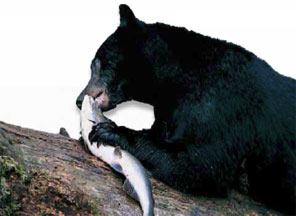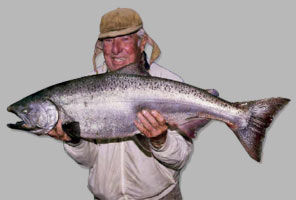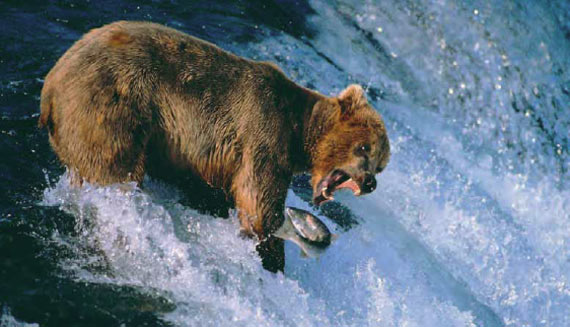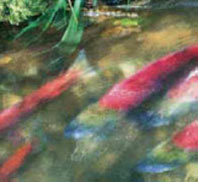Wild Salmon and the Circle of Life
Wild salmon are a gift of nature. One of the world’s healthiest foods, they are a rich source of Omega-3 fatty acids, potassium, Vitamin D, the B vitamins, phosphorus and protein – all of which reduce the risk of heart disease and stroke, dementia and Alzheimer’s, different types of cancer, depression and hypertension, just to name a few of America’s most insidious diseases. The innate food benefits, unreplicated in farmed salmon or in supplements, are reportedly a critical factor in the health and longevity of many Native Alaskans – particularly the Inuit, formerly known as “Eskimos.”
Once swimming in abundance throughout much of the Atlantic and Pacific Oceans, wild salmon have dwindled precipitously since the days of Lewis and Clark (to less than 3 percent of their original total in the Columbia River) because of a number of primarily human-induced actions. Today’s largest salmon populations exist in northern British Columbia and in Alaska. Within the latter’s Bristol Bay region, the world’s largest and most sustainable wild salmon fishery, these bright, beautiful and tenacious fish are the keystone to the entire ecosystem’s preservation.

© Greg Syverson
Most people think of salmon as being good to eat and good for you, but most don’t know the fascinating story behind these remarkable fish. Indeed, they possess phenomenal adaptive characteristics that enable their unique life cycle and cause them to have profound effects upon the environment. According to David Johnson from the Washington State Department of Fish and Wildlife, salmon “. . . are a major source of high-energy food” necessary to the survival of many other wildlife species such as the bald eagle, Caspian terns, harlequin ducks, killer whales, river otters, and brown, black and grizzly bears. All have “strong consistent relationships” with salmon by depending largely upon them for sustenance. In fact, a study by Scott Gende, et. al. of the National Park Service showed that of 1,933 salmon tagged in three different streams of southwest Alaska, 64.3 percent of them were killed by bears alone!
Besides directly contributing to a large part of various wildlife diets, salmon indirectly supply all animals and plants in their habitats with nutrients that would otherwise not be present. These extraordinary contributions to so many other wildlife species lead to salmon’s designation as a “keystone” species, according to Milo Adkison from the School of Fisheries and Ocean Sciences, University of Alaska, Fairbanks. Being a “keystone” is like being the beginning point of a domino effect; a change in a “keystone” may result in alterations over time for all wildlife with a relationship to it. Thus, in the Pacific Northwest, and especially in southwest Alaska where they abound, salmon have a critical and irreplaceable impact on the ecosystem.
One of the most crucial adaptive characteristics to salmon’s existence is “anadromy,” which is their ability to live in both fresh water and in salt water. This adaptation allows salmon to have an intricate life cycle, maximizing the benefits from freshwater and saltwater habitats in different ways. For example, juvenile salmon benefit from rearing in freshwater lakes and streams because of decreased risk of predation. However, freshwater habitats provide limitations resulting from less available food. Because it’s in a salmon’s best interest to grow as large as possible to produce the largest number of eggs to sustain the species, the juvenile salmon migrate to the ocean, where the food supply is more abundant and where they can more safely mature into fully grown adults.
Salmon are able to bridge these vastly different habitats because they undergo a unique physiological change, called “smoltification,” in estuaries where the waters of the two vastly different worlds of rivers and oceans collide. While young and living in freshwater, salmon excrete excess water through their kidneys and take up salt through their gills. However, this process is reversed during smoltification, enabling the salmon to actively excrete salt and to take up water – a unique process.

© Greg Syverson
Bruce Hampton’s Rivers of Life essay, featured alongside Robert Glenn Ketchum’s stunning photography, gives an eloquent account of the life cycle and journey of salmon. This species’ incredible life journey begins with a very small “. . . fluid-filled egg containing the genetic material that will dictate the adult salmon’s size and shape and provide the framework that enables salmon to create a ‘map’ of the Northern Pacific.” Thus, the phenomenal ability for salmon to navigate thousands of lifetime miles is a gift from birth. Salmon are predictable, and Hampton attributes their precise schedules to an internal biological clock, based on circadian rhythms, which enable the fish to keep track of the time of year and the year itself. That is why, later in life, adult salmon are able to return annually to their freshwater homes to spawn at the same time.
Salmon also possess a mechanism enabling them to gauge direction, as any navigator must. Hampton describes how the species create a navigational “map” utilizing cues from celestial objects like the stars and the sun. However, in response to the Northern Pacific’s problem of often being cloudy, Hampton says researchers have discovered an extraordinary substance, called “magnetite,” in salmon brains. Magnetite acts as an organic magnet and allows the fish to gauge their position—a unique utilization of the magnetic declination of the earth when celestial reference points aren’t visible. In addition to their phenomenal abilities to navigate the oceans, salmon possess one more advantage from birth, their olfactory senses, which are so finely tuned that they can detect the smell equivalent to only one drop of water from their home tributaries in 500,000 barrels of river water.
Until now, the tiny salmon egg containing its amazing navigational framework has lain shallowly buried in gravel by its mother, continues Hampton. This fortified incubation space provides protection from predators such as trout and birds throughout the cold winter months. In early spring a small salmon minnow or “fry” will leave the gravel for the water’s surface and breathe life-giving oxygen into its gills for the first time. This first inhalation provides the buoyancy needed to float downstream to lakes and to remain for a year or two. Adkison notes that this can be a troubling time as trout, larger salmon and many kinds of birds target the “fry” for food. When the young salmon are approximately two to three inches long, they are ready to head off to the ocean to undergo smoltification in the gradually more salty environment of estuaries. As this is a delicate time, Johnson explains that the salmons’ weak state is an advantage to various predators such as river otters, Caspian and Arctic terns, gulls, larger fish plus even sea lions and seals.
Finally, salmon smolts reach the ocean environment where they will mature into fully grown adults over several years of ocean cruising and feeding. In this stage, they swim 10-30 miles per day in a counter-clockwise circuit around the Northern Pacific. As they journey, they grow larger by feeding off squid, krill, juvenile fish and zooplankton, which contribute to salmon’s rich red muscle color. The ocean becomes a great predatory risk even to adult salmon although they possess impressive speed. During this time, according to Johnson, larger fish, beluga whales, sea lions and great orca whales feast on salmon. By the second or third year at sea, a fully mature adult salmon’s approximate weight is between four and one-half and six and one-half pounds.

© Greg Syverson
Following the mental calendar they are given at birth, salmon begin the trip home in late June and early July. Bruce Hampton’s Rivers of Life essay describes this period as “. . . the time to see the bays’ lower rivers choked with returning fish. One day they’re empty; the next, overflowing with salmon.” He continues, “. . . they move in pods of tens, hundreds or even thousands along stream edges where the currents are slowest.” They cease feeding and rely upon their stored fat supply to fuel their journey – each day progressing 20-60 miles a day up stream. Changes are confirmed visually as salmon lose their ocean dwelling silvery pigment for bright crimson flanks and green-purple heads.
Southwest Alaska’s salmon populations gain a substantial benefit because of numerous rivers, large lakes and streams that abound in the region and provide opportunity for a diverse gene pool. According to Hampton, genetic variations of the area are demonstrated by distinctive colors, sizes, flesh textures and, arguably, even tastes. Once again salmon act as dinner for a new and varied group of hungry consumers such as sea lions, bears, bald eagles, mink, wolves, seabirds and songbirds but, this time, as returning adults. Bears, in particular, show notable behavior changes with the salmons’ return to freshwater habitats. Usually solitary creatures, who generally avoid other bears, they have been known to gather in groups as large as 60 to feast on energy-rich salmon in anticipation of their coming winter hibernation. University of Alaska’s Adkison also notes that the population of the national bird, the bald eagle, has correlated with the population of returning salmon.
Humans have created a huge, historical dependence on adult salmon during the famous Southwest Alaska runs. Native Alaskans, like Pacific Northwest natives, have been capitalizing off salmon’s benefits for thousands of years. Salmon fisheries and processing industries have been major contributors to the Alaskan economy since the late 1800s. In addition to tribal and commercial fishing, Hampton notes that Alaska’s world-famous salmon populations attract a huge tourism market wishing to witness the planet’s largest population first-hand in this uniquely pristine environment.
After spawning, salmon begin to have their largest impact yet with a nutrient-rich contribution to the freshwater environment. Because they have utilized 90 percent of their fat reserves to make the long journey home, salmon have lost nearly half of their body weight and begin to deteriorate. Hampton describes the horrific smell that the rotting salmon contribute to the air for a short period of time. As the pungent stench begins to wane, one begins to recognize the distinct waft of the ocean unfamiliar to freshwater locals. Adkison describes this process of decaying carcasses as indirectly providing marine-derived nutrients (MDN) to freshwater lakes which contribute to overall productivity of the ecosystem. MDN represent a unique isotropic balance of nitrogen, phosphorus and organic carbon compounds that are not typical of freshwater habitats but that provide enormous benefit to the food webs of both Alaskan lakes and streams.
First, huge blooms of plankton depend on the decomposing salmon as their primary food source. This plankton, in turn, provides sustenance to juvenile fish, including juvenile salmon that forage directly on the adult salmon carcasses. According to Adkison, MDN are incorporated into both plankton and juvenile salmon as well as into terrestrial plants and soils, producing a notable increase in the growth of spruce trees. He continues, “. . . even wine grapes have been shown to grow better in drainages with spawning salmon!” Some studies have shown that tree ring analysis has gauged how large a returning salmon population was in a given year.

© Greg Syverson
As demonstrated, salmon are huge contributors during all stages of their life cycle and even in their death. Thus, changes in their population size can have far-reaching effects for other ecosystem members throughout the shared habitat. According to Johnson, almost all populations of Atlantic salmon in the eastern United States have become extinct; in addition, many of the Pacific populations of Washington, Oregon and California are qualified as “endangered,” according to the Endangered Species Act, while some populations are completely extinct. Johnson and other researchers outline several likely explanations for Pacific Northwest salmon population losses, all of which are the result of human interference: exploitation from commercial fishing, river channelization, log driving, land clearing, mining runoff pollution, removal of old growth forest, hydroelectric dam development, urban runoff, water and sediment contamination with toxic substances and a changing ocean environment possibly attributed to changing global temperatures.
Remarkably, in the face of all this, Alaskan salmon populations have “. . . remained some of the healthiest in the world; and many of the stocks seem to be self-sustaining while still supporting larger commercial fisheries,” Adkison says. Unlike in the Pacific Northwest, he points out, “Much of the freshwater habitat in Alaska remains in relatively pristine condition.”
The fate of once-great salmon populations, such as in Oregon’s Columbia River valley, where millions of salmon have disappeared from their historically documented home territory, must not be ignored by those who care about Alaska’s still thriving extraordinary wild salmon. Predictive patterns resulting from humankind’s documented negative effect on these now gone or critically endangered populations, such as the introduction of toxic materials into the ecosystem, need to be closely monitored and/or avoided to ensure the sustainability of Southwest Alaska’s salmon population for future generations. Americans need to ask themselves if they are willing to take a lesson from history, accept responsibility and carefully monitor further development in “the Last Frontier State.” The multitudes of wildlife and fish dependent upon salmon for their existence, as well as the fate of this relatively untouched environment that the salmon call “home,” demand our vigilance.




























